Sunday, April 19. 2009
Another photo from our walk yesterday. Does anybody have a clue what these yellow flowers are? It was growing in clumps in lawns.
The leaves are a bit pansy-looking and low, and the flower stalks around 6-7" high.
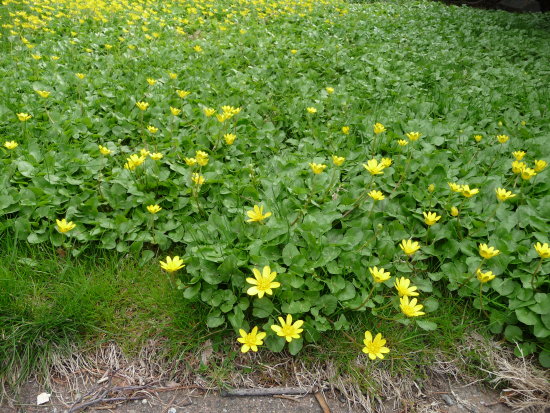
Friday, March 20. 2009
 For those who live in the northern parts of the world, just a reminder: unless you live in an area with remarkably fertile soil, your lawns, perennials and some of your shrubs count on some fertilizer because none of them are truly natural (they are all genetically-engineered and hybridized), nor do they receive what nature would otherwise supply them for free (rotten leaf mold, flooding silt, bear, human, and Wooly Mammoth poop, etc). For those who live in the northern parts of the world, just a reminder: unless you live in an area with remarkably fertile soil, your lawns, perennials and some of your shrubs count on some fertilizer because none of them are truly natural (they are all genetically-engineered and hybridized), nor do they receive what nature would otherwise supply them for free (rotten leaf mold, flooding silt, bear, human, and Wooly Mammoth poop, etc).
My point is that it's easy to forget that the roots wake up and begin growing and seeking nourishment long before any buds appear.
Not only that, but it takes a while for your fertilizer to get down to the roots. Time and rain. March and early April is the time to give your precious plants a good head start up here in the north country.
And, yes, this is a metaphor too.
Sunday, March 8. 2009
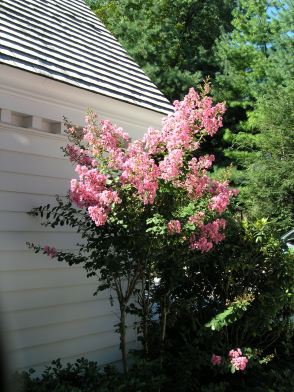 Pruning is a subject of great interest to us, as it is to all gardeners. It is now the last chance to do our winter pruning of those late-blooming shrubs and trees which bloom on new growth. Pruning is a subject of great interest to us, as it is to all gardeners. It is now the last chance to do our winter pruning of those late-blooming shrubs and trees which bloom on new growth.
This site from Texas A&M is an excellent pruning overview, with special attention to the pruning requirements of Crepe Myrtle.
Shrubs which are pruned wrong offend my delicate gardening sensibilities.
Photo: One of my young Crepe Myrtles blooming a couple of Augusts ago. Up here in Yankeeland, north of their growing zone, they have a small chance of thriving if they are a hardy variety, and are well-sheltered and well-mulched for the winter. Mine do just fine. While they are commonplace in the South, up here nobody seems to know what they are.
As with hybrid Rhodadendrons and azaleas, it's an iffy proposition up here - but well-worth when it works.
Sunday, October 19. 2008
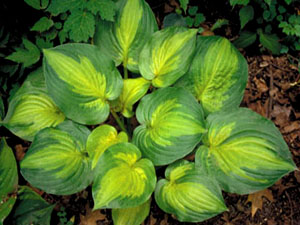 Taking a little break from fall planting. Last chance to do some lawn reseeding and to transplant, and to plant the last shipment of perennials hereabouts. I had to make a new small perennial border, under orders. Many bags of cow manure and peat moss from Home Depot, along with compost, to happify the lousy glacial soil we have here. Taking a little break from fall planting. Last chance to do some lawn reseeding and to transplant, and to plant the last shipment of perennials hereabouts. I had to make a new small perennial border, under orders. Many bags of cow manure and peat moss from Home Depot, along with compost, to happify the lousy glacial soil we have here.
Simple pleasures. I like digging in the dirt, and I believe in digging and enriching 18" for new perennial plantings. You can only do it once. Mostly rare Hostas, of course. Mrs. BD is an afficianado. Photo is "Dance with Me." Nice enough Hosta, but you have to get into it to fully appreciate. To get a clue, try Hosta Library. Do me a favor: never plant Hostas in the sun. Terrible thing to do. And always en masse, or they will offend my delicate gardening sensibilities.
Friday, October 3. 2008
My Montauk Daisies always come into bloom in the first week of October. It's worth the wait but, depending on the first frost, their bloom time can be brief. Advice to those who grow them: They don't need fertilizer. They want full sun. Prune them to 4-6" high each early spring or you will end up with a huge, scraggly shrub a bit like the one below. 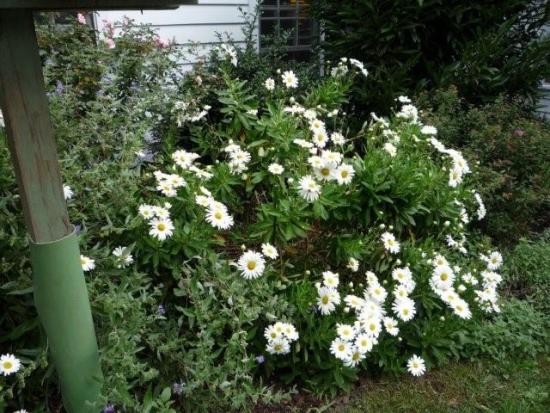
Tuesday, September 30. 2008
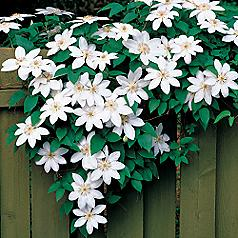 This is Clematis Henryi. I have just ordered one to grow over an arbor. This is Clematis Henryi. I have just ordered one to grow over an arbor.
In my experience, these are tricky plants and slow to establish themselves. When they are unhappy, there's not a damn thing you can do about it. When they are happy on a sunny fence, they are great. They supposedly like their feet cool, shaded, and mulched. I've tried everything but, like people, they just go their own way and follow their own path, whether it leads to heaven, hell, or Paramus. I also like Sweet Autumn Clematis, which is a tougher, more forgiving variety.
Sunday, September 28. 2008
Friday, September 26. 2008
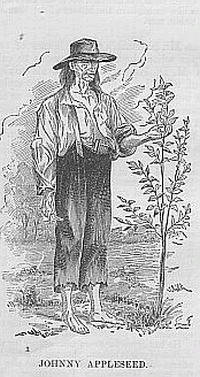 Johnny Appleseed - John Chapman - was an interesting character: an ascetic, a Swedenborgian missionary, and a nurseryman who had little interest in making money. Johnny Appleseed - John Chapman - was an interesting character: an ascetic, a Swedenborgian missionary, and a nurseryman who had little interest in making money.
Read about him and his unusual life at a good Wiki entry.
Tuesday, September 23. 2008
 As readers may have noticed, with the beginning of Apple Season in Yankeeland we are making a point of having at least one Apple post daily. As readers may have noticed, with the beginning of Apple Season in Yankeeland we are making a point of having at least one Apple post daily.
Here's Apple Trees: Where and how to plant. Image is by Nicholas of Verdun (c. 1180)
Friday, August 29. 2008
Along the streambank at the farm: 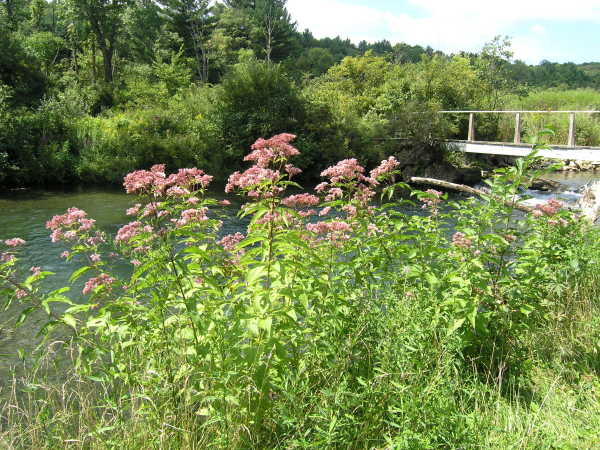
Tuesday, August 26. 2008
In full bloom, with plenty of Ruby-Throated Hummingbirds buzzing around. Weeds? I don't see any weeds. Monarda itself is almost a weed. What's a "weed," anyway? 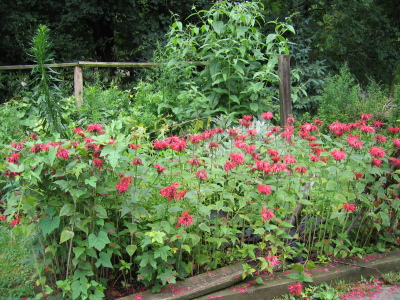
Sunday, August 3. 2008
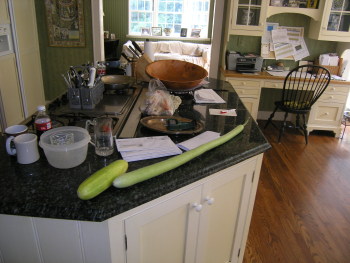 Bird Dog gave me some seedlings to try in the garden, warning me that they don't grow like squash, but like gourds. (They are an edible gourd, same as pumpkin.) Bird Dog gave me some seedlings to try in the garden, warning me that they don't grow like squash, but like gourds. (They are an edible gourd, same as pumpkin.)
Vigorous doesn't describe it. These things are like Jack's beanstalk, and bugs leave them alone. You're supposed to pick them before they get much over a foot long. Americans may consider them to be an Italian heirloom vegetable, but they are grown all over Asia. You peel them and cook like summer squash. Sometimes people fry them, too. Photo: A cucuzzi, with an overgrown cucumber for comparison.
Saturday, July 19. 2008
A re-post: 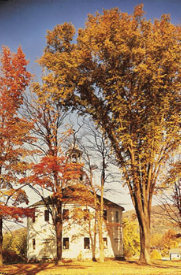 Both the majestic American Elm and the Chestnut fell victim to blights imported from overseas. With their deaths, the New England landscape was altered, for the worse. No more village blacksmith "under the spreading chestnut tree," and no more village greens and churches graced by rows of giant vase-shaped Elms - the hallmark of old New England. Both the majestic American Elm and the Chestnut fell victim to blights imported from overseas. With their deaths, the New England landscape was altered, for the worse. No more village blacksmith "under the spreading chestnut tree," and no more village greens and churches graced by rows of giant vase-shaped Elms - the hallmark of old New England.
Yes, we still have some elms, but the young ones don't make it to adulthood, and any remaining trees are slowly dying off. The good news is that there is a blight-resistant Elm available. You won't live long enough to see it in its glory, but planting some now in the right places will be a heck of a fine gift to the future. You can find them at Miller Nurseries.
Wednesday, July 2. 2008
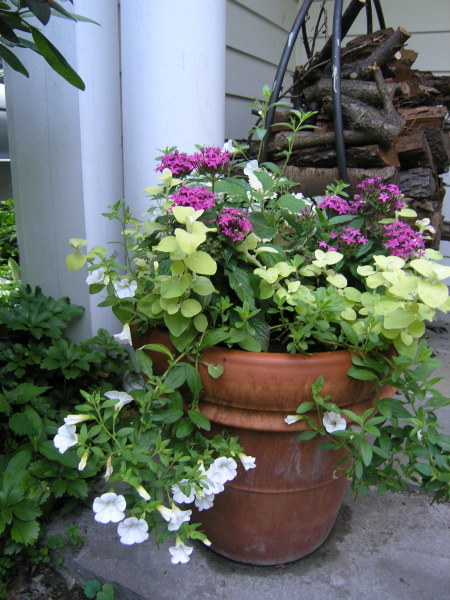 Mrs. BD thought there might be some interest in the subject of growing perennials - rather than annuals - in your containers. It's a bit late in the season to post this, but I will do so anyway, and re-post it next May, God willing. Mrs. BD thought there might be some interest in the subject of growing perennials - rather than annuals - in your containers. It's a bit late in the season to post this, but I will do so anyway, and re-post it next May, God willing.
Since it might cost $50 to pack a good-sized container with annuals, and since perennials are generally more attractive and interesting, it might be worth a try. We have occasionally been happily surprised to see perennials in containers coming back to life in Spring. The trick is overwintering them. Here's a site that explains it all. Photo is one of my containers, filled with about $40 of annuals. Should have tried some perennials.
Friday, June 13. 2008
Clematis on a picket fence in CT this month. Thanks, reader. 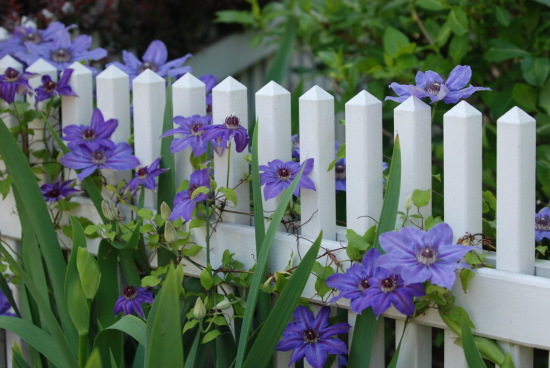
Friday, June 6. 2008
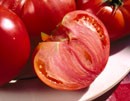 It's not too late to get some tomatoes in the ground. NYT
Monday, June 2. 2008
A close-up of a bit of the shade border, yesterday. Yes, our azaleas are in bloom now up here. 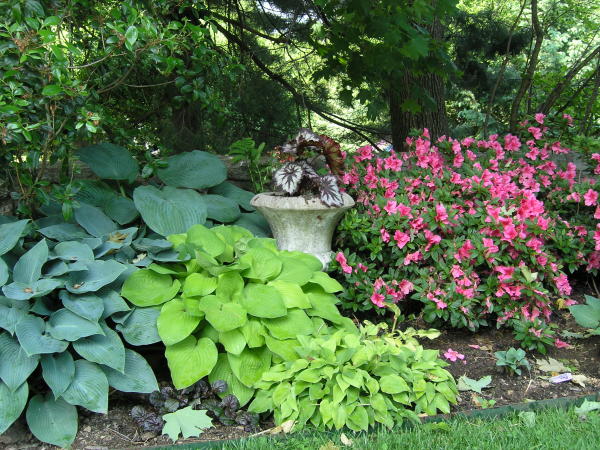
Wednesday, May 28. 2008
 Many people swear by this stuff for their vegetables and perennials, including my Mom, who knows whereof she speaks: Sea Kelp Liquid Fertilizer. Many people swear by this stuff for their vegetables and perennials, including my Mom, who knows whereof she speaks: Sea Kelp Liquid Fertilizer.
It's difficult to find, except online.
Tuesday, May 27. 2008
For readers who remember (or care about) the shade perennial border that I was working on finishing up last spring, here is about half of it, one year later, from two angles. (Sorry about my lousy photography.) I am pleased by how well it is shaping up after just one year: 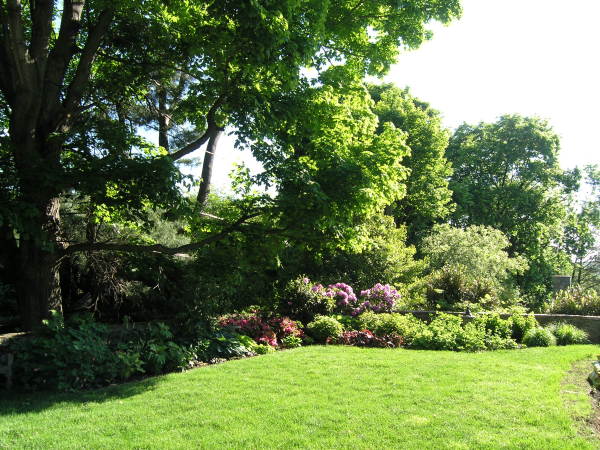
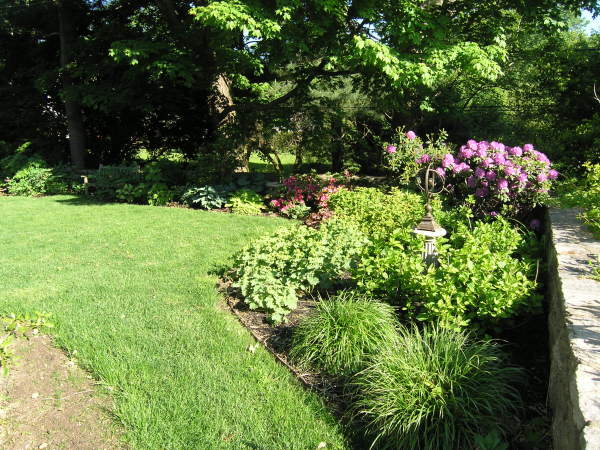
Sunday, May 25. 2008
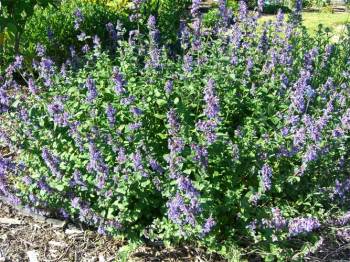 What is getting planted this weekend, besides a ton of basil (and I think I need much more) in the veggie garden: What is getting planted this weekend, besides a ton of basil (and I think I need much more) in the veggie garden:
- A nice large mass of Nepeta (Catmint, not to be confused with Catnip). Photo on right. - A 20' shade border edge of Green Spice heuchera. Look how it changes color with the seasons. This variety is a very cool plant. - 20 obscure and delightful Hostas, including Love Pat. We think Hostas look best planted as "wave" plantings in the shade (never in the sun), such that, when mature, the leaves of one plant touch those of the adjacent plant and prevent weeds. For the right effect, that means mass planting of at least 5-10 of the same type, usually, unless you have a spot for a "specimen" plant. To do it right, you have to know what size the darn plant will become. Hostas come in mini, small, medium, large, and extra-large. A medium plant will be 2 1/2-3' across at maturity. An extra-large variety can be 5-6' wide at maturity if it is happy. Hostas mature fairly slowly (3-4 years, like most perennials), and if you divide them they revert and start their maturation process all over again. Best to plant them right the first time, and then leave them alone forever except for some fertilizer in Spring and early Fall. I keep mine well-mulched - most easily done when they first emerge, but before the leaves unfold. Once they unfold, it's tough to do. Do I enrich the soil when I plant them? You bet I do. The old rule is a $50 hole for a $5 plant (unless it's a herb sort of thing that likes bad soil): twice as deep and twice as wide as you feel like digging. Big hole, soil mixed with humus or manure, and peat moss. Plenty of water the first year. And 6" of mulch (not that ugly and ineffective cedar chip crap) unless weeding gives you pleasure.
Thursday, May 22. 2008
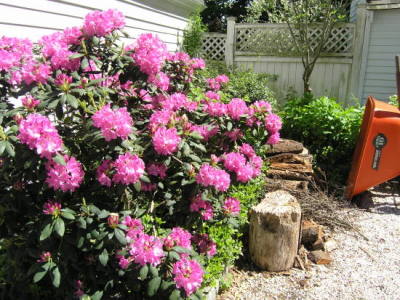 Ford's most advanced assembly plant. It's in Brazil. Ford's most advanced assembly plant. It's in Brazil.
Endangered sharks. Unsustainable exploitation of sea creatures is one of the tragedies of our age. Finally, a French appeals court proclaims the truth about al-Dura. Quickest draw in the world. Video Learn Chinese on a video game Canada has become a haven for terrorists In Verona, mosque replaced by Oriana Fallaci Square Obama leads McCain in national poll. Yikes. Popular wisdom about the role of SCOTUS The cost of food. Worldwide figures "Negotiation is not a policy. It is a technique." Bolton's latest, via No Pasaran David Warren takes a risk: Deliberately issuing a slur against aliens in Canada. How soon before the hate Nazis are on his case? Adding to our News blogroll: Afrol News, a nifty summary of the news from Africa. Photo: Your editor took this snap of his Rhodies this afternoon. Too bad I am a lousy photographer, because mine are glorious this year. Hybrid Rhodies can thrive up here in Yankeeland if they are sheltered, fertilized, acidified, and grown in rich peaty soil where they get plenty of sun - but not peak mid-day summer sun. Otherwise, they die a very slow death. Rhodies, like Mountain Laurel and Blueberries, only grow where they feel like growing. You can't tell them what to do.
Tuesday, May 20. 2008
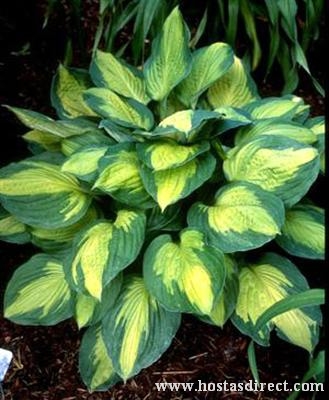 It's about the colorful and shapely foliage, not the flowers. From Bridgewood Gardens, on Why We Grow Hostas: It's about the colorful and shapely foliage, not the flowers. From Bridgewood Gardens, on Why We Grow Hostas:
I'm not a botanist, I don't know the science. But I do know that hostas have some kind of chemical in them that makes people nuts. I know people who have normal size houses, with normal size back yards, normal kids and a sensible spouse, and these people grow a thousand or more different kinds of hostas. I don't know just one of these people. I know a bunch of them. These people are obviously nuts and they have only one thing in common, they've all come in contact with hostas. Obviously, there are still people who add a few hostas here and there to their gardens and leave it at that. There must be some kind of threshold you have to cross - one day you're a sensible gardener, the next day you're nuts. I think the first sign of trouble is when you say to yourself, "I wonder how many of these things I have now."  So you count your hostas and you're surprised to realize that you already have 40 different kinds. You don't remember buying that many, you never thought of yourself as a collector, it just sort of happened. So you count your hostas and you're surprised to realize that you already have 40 different kinds. You don't remember buying that many, you never thought of yourself as a collector, it just sort of happened.
Read the whole thing about Hostaphilia. Our first post about Hostas was Hosta City. I think Hostas are OK, but it's the Mrs. who is the enthusiast and connoisseur. It takes them a year or two to get established, but after that they are tough. Few things are more pleasing or rewarding to grow in deep shade, and they are so dense that you get no weeds. Hosta Direct has a large selection. Photo on top: Hosta "Captain Kirk"
Sunday, May 18. 2008
My gardening buddies and I journey to this place each May for our vegetable plants. We go because they are the only place around here that has 30 varieties of tomatoes (including the yellow pear-shaped cherry tomatoes and all sorts of heirloom tomatoes), and 15 varieties of Basil and five varieties of Italian parsley, etc., in their herb shed (not that you want that many - it's just fun to see them all). This was yesterday morning: 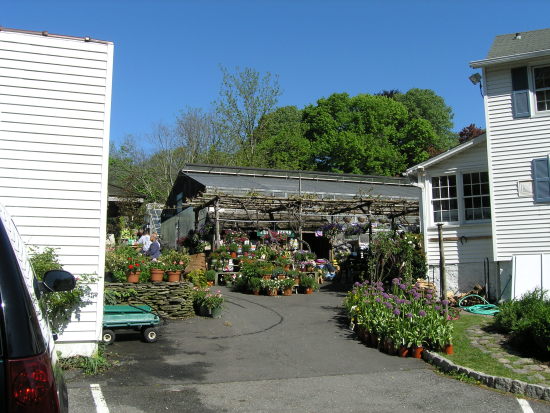
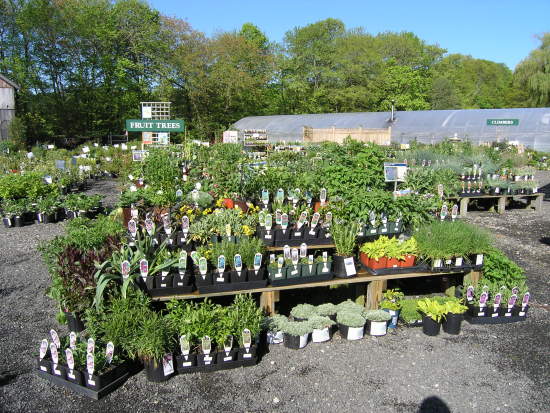 
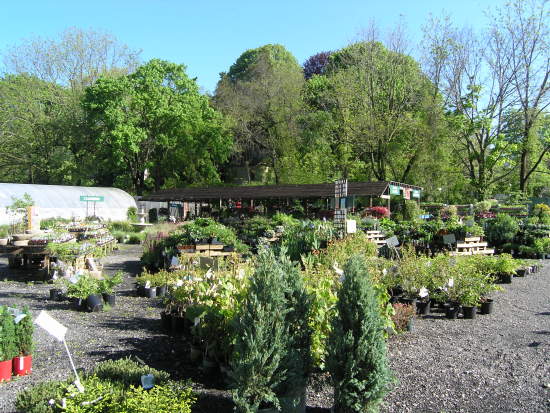
Saturday, May 17. 2008
As of today, we can put vegetables in the ground up here. Got the garden ready? 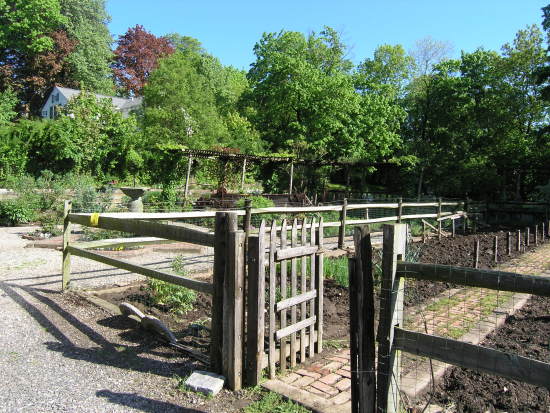
Saturday, May 3. 2008
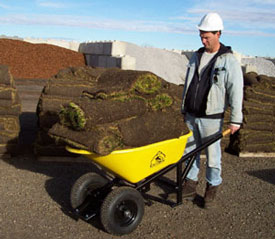
Why is a wheelbarrow load of soil or firewood easier to move around than a wagon load? It's not spring yet, but I recently had a discussion about this subject, which led to some minor research. Like simple devices like the nutcracker, the human arm, scales, a see-saw, the crowbar, ratchet wrench, scissors, catapults, and the fishing rod, a wheelbarrow is a lever. In fact, a Type 2 Lever. By a miracle of physics, levers magnify the force that can be applied with a given amount of effort. Archimedes was the first to attempt to describe the principles of levers. As the physics limerick goes: One morning while eating my Wheaties,
I felt the earth move 'neath my feeties.
The cause for alarm
Was a long lever-arm,
At the end of which grinned Archimedes.
So, using by using your body to apply effort, with lever action, you are magically carrying a fair amount of the load of the wheelbarrow. A wagon offers no such advantage. (I will spare you the math with the factors of friction, torque, vectors, etc. that make a seemingly simple tool like a wheelbarrow surprising challenging to define.) (As an aside, let me ask whether they let kids nowadays graduate from high school and college without taking calculus, physics and statistics? If so, wrong, wrong, wrong. This stuff is BASIC. An educated person knows Latin or Greek, calculus, basic physics, basic chemistry, and statistics. Or they are only half-educated about reality and seriously handicapped in the tools for understanding this world. Saddest thing: you forget it all, over time, but, like bike-riding, it's in there somewhere, and the brain can re-connect with it with the right "links".) I am partial to two-wheelers. The increase in friction, I feel, is compensated by the lack of wobble (torque). Photo is the Ultimate Wheelbarrow from Cariola.
|


 Pruning is a subject of great interest to us, as it is to all gardeners. It is now the last chance to do our winter pruning of those late-blooming shrubs and trees which bloom on new growth.
Pruning is a subject of great interest to us, as it is to all gardeners. It is now the last chance to do our winter pruning of those late-blooming shrubs and trees which bloom on new growth. Taking a little break from fall planting. Last chance to do some lawn reseeding and to transplant, and to plant the last shipment of perennials hereabouts. I had to make a new small perennial border, under orders. Many bags of cow manure and peat moss from Home Depot, along with compost, to happify the lousy glacial soil we have here.
Taking a little break from fall planting. Last chance to do some lawn reseeding and to transplant, and to plant the last shipment of perennials hereabouts. I had to make a new small perennial border, under orders. Many bags of cow manure and peat moss from Home Depot, along with compost, to happify the lousy glacial soil we have here.
 This is
This is 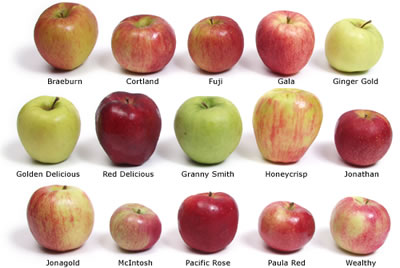
 Johnny Appleseed - John Chapman - was an interesting character: an ascetic, a Swedenborgian missionary, and a nurseryman who had little interest in making money.
Johnny Appleseed - John Chapman - was an interesting character: an ascetic, a Swedenborgian missionary, and a nurseryman who had little interest in making money.  As readers may have noticed, with the beginning of Apple Season in Yankeeland we are making a point of having at least one Apple post daily.
As readers may have noticed, with the beginning of Apple Season in Yankeeland we are making a point of having at least one Apple post daily.
 Both the majestic American Elm and the Chestnut fell victim to blights imported from overseas. With their deaths, the New England landscape was altered, for the worse. No more village blacksmith "under the spreading chestnut tree," and no more village greens and churches graced by rows of giant vase-shaped Elms - the hallmark of old New England.
Both the majestic American Elm and the Chestnut fell victim to blights imported from overseas. With their deaths, the New England landscape was altered, for the worse. No more village blacksmith "under the spreading chestnut tree," and no more village greens and churches graced by rows of giant vase-shaped Elms - the hallmark of old New England.
 It's not too late to get some tomatoes in the ground.
It's not too late to get some tomatoes in the ground.  Many people swear by this stuff for their vegetables and perennials, including my Mom, who knows whereof she speaks:
Many people swear by this stuff for their vegetables and perennials, including my Mom, who knows whereof she speaks:  What is getting planted this weekend, besides a ton of basil (and I think I need much more) in the veggie garden:
What is getting planted this weekend, besides a ton of basil (and I think I need much more) in the veggie garden: It's about the colorful and shapely foliage, not the flowers. From Bridgewood Gardens, on Why We Grow Hostas:
It's about the colorful and shapely foliage, not the flowers. From Bridgewood Gardens, on Why We Grow Hostas: So you count your hostas and you're surprised to realize that you already have 40 different kinds. You don't remember buying that many, you never thought of yourself as a collector, it just sort of happened.
So you count your hostas and you're surprised to realize that you already have 40 different kinds. You don't remember buying that many, you never thought of yourself as a collector, it just sort of happened.